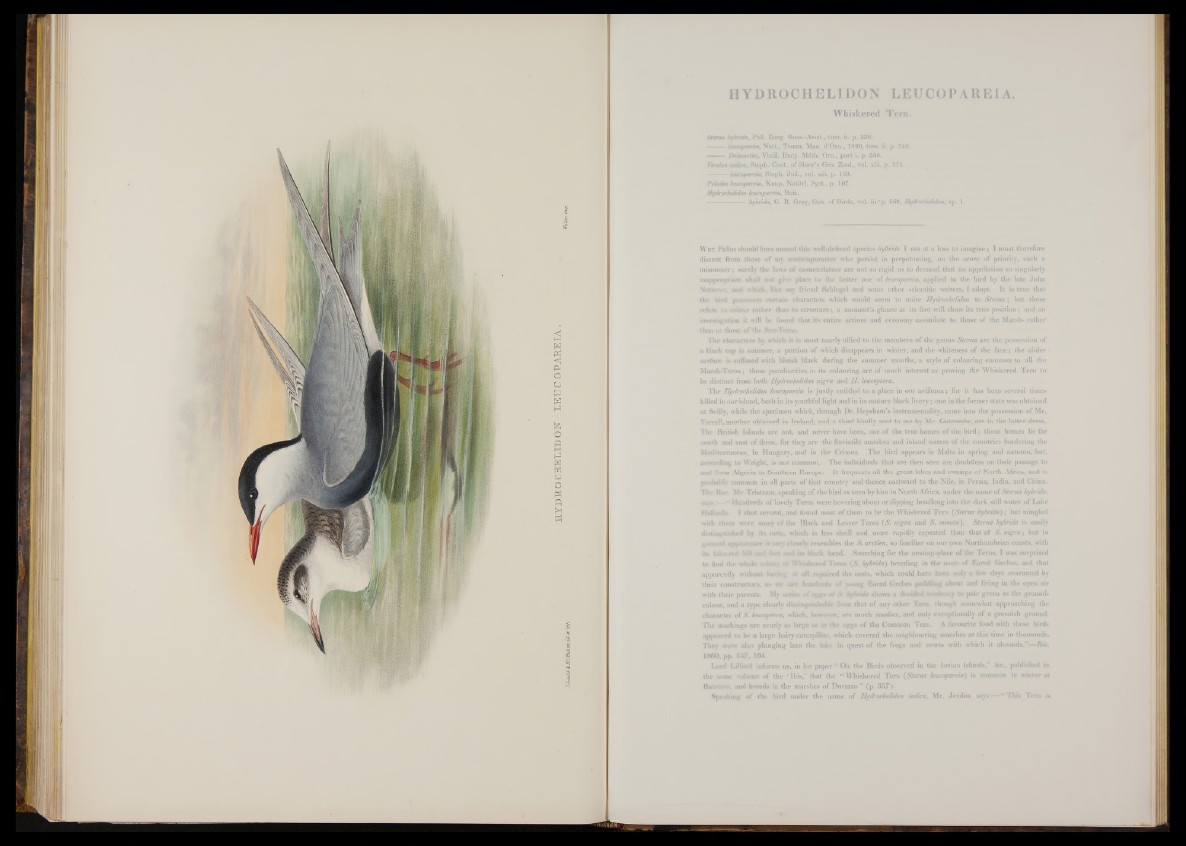
H Y D R O C H E L ID ON I E T J C O P A R E I A .
Whiskered Tern.
Sterna fn/brida, Pall. Zoog. Ross.-Asiat., tom. ii. p. 338.
leucopareia, Natt., Temm. Man. d’Om., 1820, tom. ii. p. 746.
Df lamotta, Vieill. Ency. Meth. Orn., part i. p. 360.
Viralm mdica, Steph. Cont. of Shaw’s Gen. Zool., vol. xiii. p. 171.
— —- leucopareia, Steph. ibid., vol. xiii. p. 169.
Pelodes leucopareia, Kaup, Natiirl. Syst., p. 107.
Hydrochelidon leucopareia, Boie.
kybrida, G. R. Gray, Gen. of Birds, vol. iii.'p. 660, Hydrochelidon, sp. 1.
Why Pallas should have named this well-defined species kybrida I am at a loss to imagine; I must therefore
dissent from those o f my contemporaries who persist in perpetuating, on the score of priority, such a
misnomer; surely the laws o f nomenclature are uot so rigid as to demand that an appellation so singularly
inappropriate shall not give place to the better one of leucopareia, applied to the bird by the late John
N a ttew, and which, tike my friend Schlegel and some other scientific writers, 1 adopt. It is true that
tin bird pwsesses certain characters which would seem to unite Hydrochelidon to S tern a ; but these
relate to colour rather than to structure; a moment’s glance at its feet will show its true position; and on
investigation it will be found that its entire actions and economy assimilate to those o f the Marsh- rather
than to those o f the Sea-Terns.
The characters by which it is most nearly allied to the members of the genus Sterna are the possession of
a black cap in summer, a portion o f which disappears in winter, and the whiteness of the fa ce; the .under -
surface is suffused with bluish black during the summer months, a style o f colouring common to all the
Marsh-Terns; these peculiarities in its colouring are o f much interest as proving tlie Whiskered Tern to
be distinct from both Hydrochelidon nigra and H . leucoptera.
The Hydrochelidon leucopareia is justly entitled to a place in our avifauna; for it has been several times
killed in our island, both in its youthful light and in its- mature black livery; one in the former state was obtained
at Scilly, while the specimen which, through Dr. Heysham’s instrumentality, came into the possession of Mr.
Yarrell, another obtained in Ireland, and a third kindly sent to me by Mr. Gatcombe, are in the latter dress.
The British Islands are not, and never have been, one o f the true homes o f the bird; those homes lie far
south and east o f them, for they are the fluviatile marshes and inland waters o f the countries bordering the
Mediterranean, in Hungary, and in the Crimea. The bird appears in Malta in spring and autumn, but,
according to Wright, is not common. The individuals that are then seen are doubtless on their passage to
and from Algeria to Southern Europe. It frequents all the great lakes and swamps o f North Africa, and is
probably common in all parts o f that country and thence eastward to the Nile, in Persia, India, and China.
The Rev. Mr. Tristram, speaking o f the bird as seen by him in North Africa, under the name o f Sterna kybrida,
" Hundreds o f lovely Terns were hovering about or dipping headlong into the dark still water o f Lake
Haihmia. I shot several, and found most o f them to be the Whiskered Tern (Sterna hybridd); but mingled
with them were many o f the Black and Lesser Terns (S . nigra and S. minuta). Sterna kybrida is easily
distinguished by its note, which is less shrill arid more rapidly repeated than that o f S. nig ra ; but in
general it very closely resembles the S . arctica, so familiar on our own Northumbrian coasts, with
its u U -m i Vid F.-i m i its black head. Searching for the nesting-place o f the Terns, I was surprised
to find the whole , \ *6 Whiskered Terns (S . kybrida) breeding in the nests of Eared Grebes, and that
apparently without havi«g at all repaired the nests, which could have beers only a few days evacuated by
their constructors, as we saw hundreds o f young Eared Grebes paddling about and living in the open air
with their parents. My series of eggs oí -Á, kybrida shows a decided tendency to pale green as the groundcolour,
and a type clearly distinguish aide from that of any other Tern, though somewhat approachiug the
character o f S . leucoptera, which, however, are much smaller, and only exceptionally o f a greenish ground.
The markings are nearly as large as in the eggs o f the Common Tern. A favourite food with these birds
appeared to be a large hairy caterpillar, which covered the neighbouring marshes at this time in thousands.
They were also plunging into the lake in quest o f the frogs and newts with which it abounds.”—Ibis,
1860, pp. 157, 164.
Lord Lilford informs us, in his paper" On the Birds observed in the Ionian Islands,” &c.t published in
the same volume o f the ‘ Ibis,’ that the " Whiskered Tern (Sterna leucopareia) is common in winter at
Butriiito, and breeds in the marshes o f Durazzo ” (p. 357).
Speaking of the bird under the name o f Hydrochelidon indica, Mr. Jerdon says:—" This Tern is